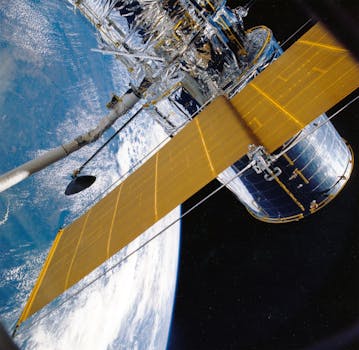The Future of Satellites: Revolutionizing Global Communication and Exploration

The Future of Satellites: Revolutionizing Global Communication and Exploration. The future of satellites holds immense potential for transforming global communication, exploration, and our daily lives. With advancements in technology, satellites are becoming increasingly powerful, efficient, and accessible. In recent years, we have witnessed significant improvements in satellite design, launch systems, and operational capabilities, paving the way for a new era in space exploration and development.
Satellites have been a crucial part of our daily lives for decades, providing essential services such as navigation, communication, weather forecasting, and remote sensing. However, the next generation of satellites is expected to play an even more significant role in shaping our future. From enabling global internet connectivity to facilitating deep space exploration, the possibilities are endless. One of the most exciting developments in the field of satellites is the emergence of satellite constellations. These constellations, comprising hundreds or even thousands of small satellites, are designed to provide global coverage and high-speed internet connectivity.
Companies like SpaceX, Amazon, and OneWeb are at the forefront of this revolution, launching large constellations of satellites into low Earth orbit. These constellations have the potential to bridge the digital divide, providing internet access to remote and underserved communities around the world. Moreover, they will also enable a wide range of applications, including IoT, smart cities, and precision agriculture. Another area where satellites are expected to make a significant impact is in the field of Earth observation. With the help of advanced sensors and imaging technologies, satellites can monitor the health of our planet, tracking changes in climate, deforestation, and natural disasters.
Advancements in Satellite Technology
Advances in satellite technology are driving innovation and growth in the industry. One of the key areas of development is in the field of propulsion systems. New propulsion technologies, such as electric propulsion and advanced ion engines, are enabling satellites to maneuver more efficiently and extend their lifespan. Additionally, the use of 3D printing and other advanced manufacturing techniques is allowing for the creation of complex satellite components, reducing production time and costs.
Another significant advancement is in the area of satellite materials and design. The development of new materials, such as advanced composites and smart materials, is enabling the creation of lighter, stronger, and more efficient satellites. Furthermore, the use of modular design and standardized components is simplifying the satellite development process, making it more accessible to new players and reducing the overall cost.
The emergence of small satellites, also known as CubeSats, is another exciting trend in the industry. These tiny satellites, often no larger than a shoebox, are relatively inexpensive to build and launch, making them an attractive option for researchers, startups, and developing countries. Small satellites are being used for a wide range of applications, from Earth observation and communication to space weather monitoring and asteroid tracking.
Challenges and Opportunities
While the future of satellites holds immense promise, there are also significant challenges that need to be addressed. One of the major concerns is the growing problem of space debris. As more satellites are launched into orbit, the risk of collisions and debris generation increases, posing a threat to operational satellites and the environment. To mitigate this risk, the development of sustainable technologies and responsible satellite operations practices is crucial.
Another challenge facing the satellite industry is the need for international cooperation and regulation. As the number of satellites in orbit increases, the need for clear guidelines and standards becomes more pressing. This includes issues such as frequency allocation, orbital slots, and liability in the event of accidents. The development of global regulations and standards will be essential for ensuring the long-term sustainability of the satellite industry.
Despite these challenges, the opportunities presented by satellites are vast and varied. From enabling global communication and exploration to driving innovation and economic growth, the impact of satellites will be felt across numerous industries and aspects of our lives. As we look to the future, it is clear that satellites will play an increasingly important role in shaping our world and addressing some of humanity’s most pressing challenges.
Conclusion
In conclusion, the future of satellites is a exciting and rapidly evolving field, with significant advancements in technology, design, and applications. As we continue to push the boundaries of what is possible with satellites, we can expect to see major breakthroughs in global communication, exploration, and our daily lives. Whether it is enabling internet connectivity, monitoring the health of our planet, or facilitating deep space exploration, the possibilities are endless.
As the satellite industry continues to grow and mature, it is essential that we address the challenges and opportunities that arise. By working together to develop sustainable technologies, responsible operations practices, and global regulations, we can ensure that the benefits of satellites are realized for generations to come. The future of satellites is bright, and it will be fascinating to see how this technology continues to shape our world and inspire new discoveries.
References
For more information on the future of satellites, please refer to the following sources: NASA, Satellite Industry Association, Space.com.

